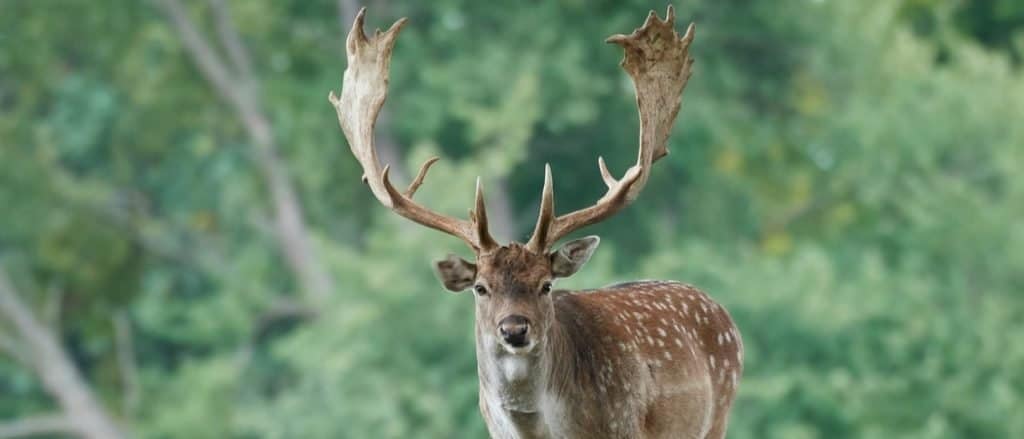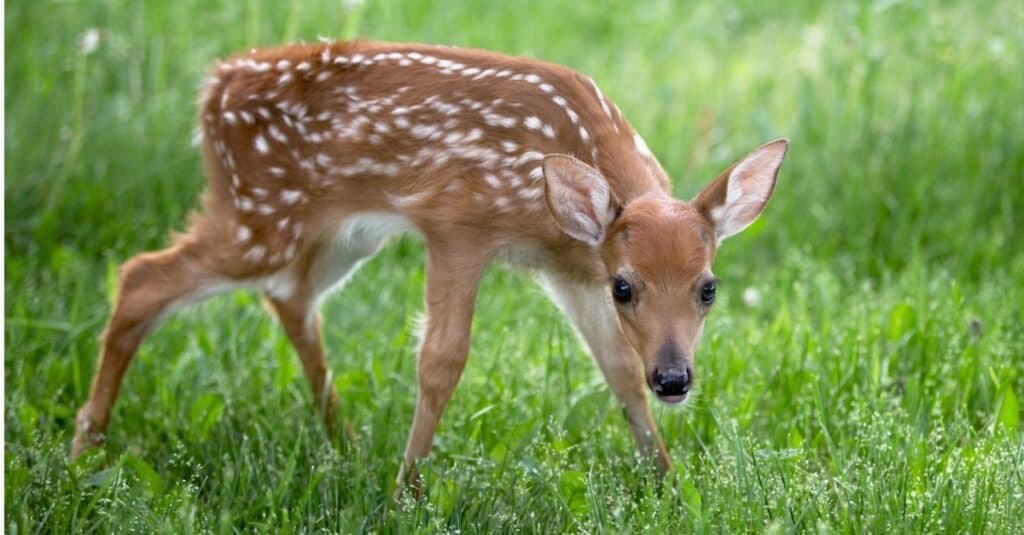We investigate the fallow deer vs whitetail deer because it’s intriguing to build general knowledge about the world in which we live. Fallow deer are so prolific throughout the globe, having been the favorite prey of European royalty, American hunters, Australia, the Caribbean, Asia, and now, even South Africa. Perhaps the white spots that are identifiable markings from birth to adulthood made this animal a symbol of empires and widespread across continents. But, whatever the case, the Fallow deer became a symbol of cultures worldwide.
The whitetail deer, also known as the Virginia deer, is another common species and is highly adaptable to most environments. You can quickly identify this animal by their striking white tails, which they raise when startled. And similar to the fallow deer, it is classified as medium-sized. However, their size varies between locations, and they tend to grow larger the further from the equator they get.
Fallow Deer vs. Whitetail Deer: Comparison

| Fallow Deer | Whitetail Deer | |
| Scientific Name | Dama dama | Odocoileus virginianus |
| Shoulder Height | 39 inches | 21 – 47 inches |
| Weight | 66 – 176 pounds | 150 – 300 pounds |
| Antlers | 15 inches | 3 – 25 inches |
| Diet | Herbivore | Herbivore |
| Lifespan | 3 – 5 years | 4 – 5 years |
| Gestation | 231 – 245 days | 200 – 205 days |
| Life Expectancy | 20 years in captivity | 18 – 25 years |
| IUCN | Least concern | Least concern |
| Predators | Humans, bears, cougars, wolves | Humans, wolves, bobcats, alligators, mountain lions, coyotes, bears |
Fallow Deer vs Whitetail Size
Fallow deer and whitetail deer are very different in stature and size. The whitetail is a longer, taller, and bigger animal with more prominent antlers. And although their shoulder heights are similar, the Fallow deer weighs up to 30% less than the whitetail. Also, the largest whitetail ever recorded was a buck weighing 540 pounds, was shot and killed in Ontario, Canada, in 1977.
Fallow Deer vs. Whitetail Deer: Behavior
Fallow deer look like Bambi throughout their lives because of their distinguishing white spots. In contrast, other deer species only have white spots as young fawns but gradually lose these as they grow into adults. Besides their appearance, Fallow deer are nocturnal animals, so they do not sleep at night. Instead, they spend the time foraging for food. Before sunrise, they engage in their bedding behavior, which involves looking for a safe place to sleep, near water and far from predators. Fallow deer are somewhat shy bucks but social enough to maintain herds. These herds are small when food is scarce and larger when abundant.
Whitetail deer males compete during mating season, and sparring among males is prevalent. The males endeavor to mate with as many females as possible and mark their territory. As a result, the fawns are born with stunning white spots. They are weaned after ten weeks and stay by the mother’s side for up to two years. Their signature white tail flares up when startled and to warn predators that they have been detected. They graze and forage primarily at night.
Where Are They Found?
Fallow deer are prevalent in Africa, Asia, Europe, North America, Oceania, and South America. Whitetail deer are in America, Peru, and Bolivia. They are also in Europe and New Zealand.

Fallow Deer vs. Whitetail Deer: Fallow deer are prevalent in
Africa
, Asia, Europe, North America, Oceania, and South America.
©Dennis Jacobsen/Shutterstock.com
Diet
Fallow deer are herbivores, which means they eat plants. They eat grass and browse on leaves and bushes in the wild. While they are not picky eaters, they prefer grazing on leaves, grasses, buds, herbs, shoots, tree bark, shrubs, and flowering plants. Deer browse and graze by pulling at vegetation, using their upper dental pad and lower incisors to grind the food before swallowing.
Whitetail deer also graze and browse, with their main diet comprising grasses, legumes, shoots, leaves, and cacti. They tend to browse in winter when the grasses are too dry and lacking in nutrition to eat. Otherwise, they browse for ground vegetation such as acorns, fruit, corn, mushrooms that can be toxic to humans, and poison ivy. This eating habit is possible because of their multi-chambered stomachs. As a result, an adult deer can consume around 2,000 pounds of vegetation in a year, and a small population of 20 can destroy a forest environment.
Reproduction
Male fallow deer are ready to mate at 17 months, while females are ready at 16 months. Despite sexual maturity at a young age, the fallow deer typically only begin breeding at two years. The gestation period lasts for approximately 240 days. The mother leaves the herd for about ten days after giving birth to one fawn and rarely to twins. After that, she returns to the herd, keeping her fawn in hiding while feeding it four times daily. Mother deer then take up to 20 days to wean their fawns at about seven months, and it becomes independent at a year.
Whitetail females enter the rutting mating season in late October or early November, and some young does will leave herds that are heavily populated with males. Does reach sexual maturity at six months, but the average age of maturity is 18 months. Females birth to up to three spotted fawns in spring, usually in May or June. The young fawns can weigh from 44 to 77 pounds by the first winter. The mother will feed them four to five times a day and keep them hidden for a month before allowing them to accompany her on foraging and grazing expeditions. The foals are weaned after 8 to 10 weeks. The male fawns will leave the mother after a year, while the females will stay with the mother for another year.

Whitetail Deer vs Fallow Deer: Whitetail deer are in America, Peru, and Bolivia. They are also in Europe and New Zealand, and only Whitetail fawns have white spots, which they lose in adulthood.
©iStock.com/Lynn_Bystrom
Fallow Deer vs Whitetail: Predators
Fallow deer’s natural predators include wolves, bears, and cougars. However, hunters keep their numbers manageable in the United States as part of conservation initiatives. Like the fallow deer, people also hunt whitetails, with coyotes, bears, mountain lions, alligators, wolves, and bobcats also hunting this buck.
The photo featured at the top of this post is © Neil Clarke/Shutterstock.com
Thank you for reading! Have some feedback for us? Contact the AZ Animals editorial team.






